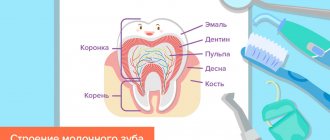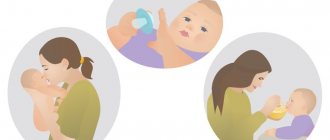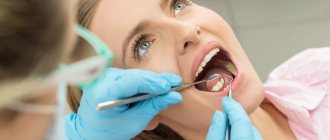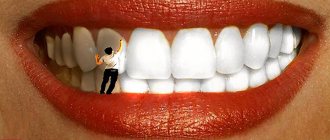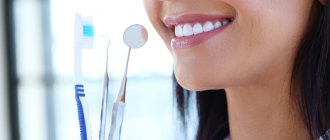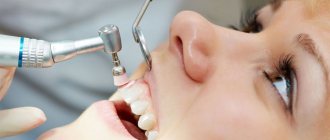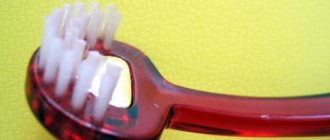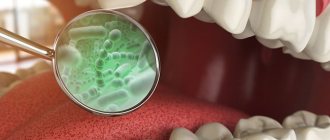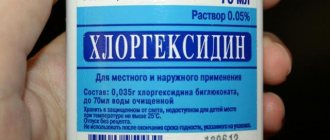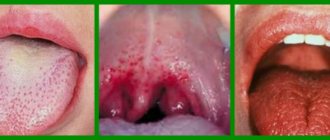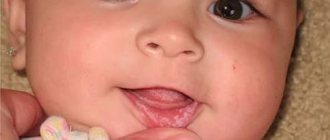Anna Andreevna Bespalova, a dentist-therapist at the Denta-El clinic, talks about what procedures are necessary to prevent and protect against oral diseases, as well as how to effectively combat diseases such as caries, stomatitis, etc.
It is common knowledge that poor oral hygiene is the root cause of all problems. However, not everyone understands why hygiene is so important. Without constant care, accumulations of plaque (at first soft) form in the mouth, becoming an ideal breeding ground for bacteria.
They digest plaque and release acids that negatively affect teeth. The layers of calcium are washed away and the enamel dissolves, becoming brittle. As a result, so-called demineralization of the enamel is observed, which ultimately leads to the formation of caries.
In childhood, this often manifests itself as white (sometimes yellow) spots on the teeth on the front side. The next stage after this is caries.
Tartar
Tartar is a soft plaque that has been in the mouth for so long that it has hardened to such an extent that it seems to “ stick ” to the tooth. At the same time, in addition to difficulties with hygiene, the stone can cause inflammation of the marginal gum - swelling and bleeding, causing constant discomfort. As a result, children try to avoid inflamed areas when brushing their teeth.
The result of this process is gingivitis and stomatitis , and in advanced cases, gum atrophy occurs along with exposure of the dental necks. The sensitivity of teeth to temperature and other influences increases significantly .
Differences between professional teeth cleaning and daily cleaning
In addition to daily morning and evening sessions with a brush and paste, other manipulations should be performed to help maintain the health of the mucous membranes and prevent the formation of plaque and tartar. Dentists advise periodically seeking professional help, because usual care at home does not provide one hundred percent protection against deposits.
Hard-to-reach places (interdental spaces, the inside of the chewing units on both jaws) are difficult to clean. As a result, an environment favorable for pathogenic microorganisms is formed in hidden areas, and pathogenic bacteria begin to actively multiply.
The process of mineralization of the soft bacterial layer is not noticeable to the naked eye. Because of this, the patient may not even realize for several months that he has tartar.
If you do not consult a doctor promptly, hardened deposits can cause serious complications. Caries, periodontitis, gingivitis and other pathological processes develop.
How do you know if you need to have your teeth cleaned at the dentist? Is it worth spending time and money visiting the clinic? Cases when this is necessary:
- subgingival or supragingival stone has formed;
- food particles have accumulated on surfaces and formed a dense whitish layer;
- the mouth smells unpleasant;
- gums bleed, pain is present;
- for preventive purposes to prevent periodontal disease and gingivitis.
How to remove plaque
Removing soft and hard plaque from teeth seems to be an elementary procedure, but, nevertheless, it requires the specialist, in addition to attention, to have some experience in such operations . The soft coating is removed with special rubber bands (or a brush). As a rule, children do not object to this - they do not experience discomfort or pain as a result of the procedure . But the importance of such a procedure is difficult to overestimate - despite its apparent simplicity, it can become an important preparation for subsequent treatment, accustoming the child to manipulations in the oral cavity.
In the case of tartar, special devices - ultrasonic or manual.
How to properly brush your baby's first teeth and care for your baby's mouth
Since hygiene must begin, as they say, from the diapers, it means you need to know how and with what tools to make this process easy and enjoyable for both parties.
FAN's interlocutor says that you can clean the first tooth with a special silicone finger brush. It is sold in pharmacies, is put on the finger and has special silicone fibers that carefully clean plaque and do not injure the enamel and delicate mucous membranes of the baby. The same fingertip can be used to massage the gums for further teething of the remaining teeth.
There are also toothpastes intended for children from zero to three years old, usually they are labeled “baby”. Their composition is specially designed for the little ones, taking into account the fact that children can swallow part of the paste. They contain absolutely nothing harmful to the child’s body and cannot provoke intoxication.
In addition, there are many teething toys of various types, made from environmentally friendly and safe materials. They are needed to relieve discomfort that occurs during teething.
In almost any children's goods store you can find an interesting and useful thing called a nibbler. This device looks a bit like a pacifier with perforated holes. You can put chopped fruits appropriate for the child’s age, such as an apple, into a silicone or fabric mesh. The baby will simultaneously receive a healthy snack, entertainment and gum massage, and the mother will not be afraid that the baby will choke.
“A very healthy, necessary and tasty thing for a baby,” sums up the expert.
If you are closer to the classic methods of brushing your teeth, then you can buy your first brush from the moment your first tooth appears; fortunately, finding one with the softest bristles in our time is not a problem.
“First, you brush your child’s teeth yourself, and then gradually get him used to using a toothbrush. The most important thing in this process is to interest the child. At the moment, stores sell a large number of interesting and beautiful toothbrushes that can attract the attention of a child. The most important thing is to do everything in a playful way, so that the child himself strives to brush his teeth, so that he has a desire to do it, and not vice versa,” notes Victoria Arutyunova.
You can buy your child his own electric brush, but keep in mind that it is better to use it starting from three or even better from four years old, when the child is able to at least hold it in his hands.
pixabay.com/
Frequency and periodicity of professional hygiene
Of course, the frequency of professional cleaning is different for each child , and depends mainly on the quality of dental care - some children brush their teeth so well that they can only be taken to a specialist annually, while others ...
When undergoing orthodontic treatment, crowded teeth or poor hygiene, preventive maintenance and professional cleaning should be performed as often as possible .
Do not underestimate the importance of professional cleaning - after all, during it, the doctor will not only teach the child how to properly care for his teeth, but will also select individual products or medications - this is especially important for various diseases or defects of the oral cavity. For example, if there is crowding, a regular toothbrush is not very effective; in this case, the child needs a special brush.
How often do children need professional dental hygiene?
Adults are recommended to undergo this procedure once every six months. But children's teeth are much more vulnerable, their enamel is not as strong, and children themselves are often not disciplined enough to brush their teeth well on their own. Therefore, it is recommended to bring children to have their teeth cleaned 3-4 times a year. This is especially true for children, whose health needs to be continuously monitored.
3-4 months is the period during which new plaque begins to harden, making it difficult to clean with a regular brush and paste.
In some cases, hygienic teeth cleaning in a children's dental office should be carried out even more often. Certain health conditions (such as kidney disease) may cause plaque to form and harden more quickly. In this case, the doctor can prescribe an individual visit schedule. There are other reasons to carry out the procedure more often, for example, the presence of braces, which inevitably contribute to the accumulation of plaque.
Features of professional oral hygiene
Oral hygiene in children three to five years old
- removal of plaque and plaque using rotary brushes (using low-abrasive pastes);
- floss polishing
- remineralizing therapy (local, using gels and jellies).
Oral hygiene in children six to ten years old
- determination of quality of care ( plaque markers
- regular teeth cleaning under the supervision of a specialist;
- hygiene index – the quality of the child’s teeth brushing, his mistakes;
- training in proper cleaning;
- repeated cleaning under the supervision of a specialist, taking into account her recommendations;
- removal of plaque and plaque using rotary brushes (using low-abrasive pastes);
- polishing with rubber heads and paste; strips (strips);
- remineralizing therapy (office or at home);
- local fluoridation using gels, jellies or varnishes.
Oral hygiene in adolescents aged eleven to sixteen
- removal of plaque and plaque using rotary brushes (using low-abrasive pastes and air-abrasive devices). For mineralized deposits - cleaning with ultrasonic tips ;
- periodontal soft tissue indices. If symptoms of inflammation are detected, anti-inflammatory treatment is carried out;
- remineralizing therapy (at the dentist or at home).
Professional oral hygiene for temporary occlusion: techniques
Professional cleaning is necessary for any teeth. It is carried out in milk, mixed and permanent dentition, removing plaque. The method of dental treatment is selected according to the age of the child. For preschoolers, use one of two options:
- Mechanical cleaning. The doctor manually cleans the grooves and smooth areas with special pastes and brushes. Carefully removes dirt from interdental spaces and hard-to-reach areas of the oral cavity. To make the child feel good, Aza&Buka dentistry uses “tasty” pastes with fruit flavors - safe and hypoallergenic. Mechanical cleaning is recommended for baby teeth and is performed for children with temporary dentition.
- Air Flow – hardware cleaning using a water-air jet with soft abrasive particles. The composition is selected taking into account the age of the young patient - powder with glycine for children over 4 years old or with calcium bicarbonate for children aged 8-10 years. Hardware cleansing removes plaque, thoroughly cleans enamel, and removes any type of pigmentation on teeth.
Ultrasonic cleaning is used to remove tartar from permanent dentition. The technique is not used for temporary teeth
Basic personal hygiene mistakes
- the procedure is performed too quickly ;
- cleaning occurs before eating ;
- no intermediate hygiene during the day (after meals);
- incorrect cleaning method. It is necessary to clean your teeth from all sides;
- insufficient care for hard-to-reach places - oral care methods
- poor selection of hygiene products. They also need to be constantly replaced with new ones;
- abuse of bleaching pastes based on peroxide compounds (usually with increased abrasive properties). This leads to the spread of pathogens .
All these mistakes often result from a lack of awareness among children and parents themselves about proper oral hygiene. To avoid this, regular consultations with an orthodontist are necessary.
Gum care in the first months of life
The first six months of life is the period when microbes populate the child’s mouth , which means that there is an increased likelihood of diseases - caries, stomatitis, infantile thrush, etc. Parents and other relatives often cause such diseases by transmitting germs to the baby through kisses, pacifiers, dishes and neglect to wash objects with boiled water. To minimize the risk, your child should wipe their gums with special wipes or finger tips every time after eating.
Cleaning baby teeth
Children should brush their baby teeth with a special brush for babies . At the beginning, the cleaning time should be 15-20 seconds , then the duration should be gradually increased . The most difficult thing at this moment, of course, is to arouse the child’s interest in this boring activity, from his point of view.
There are two methods as old as the world that have never lost their effectiveness:
- Turn hygiene training into a game - what little kid wouldn't love a flying spaceship brush or a superhero protecting his teeth? If the child is interested, he will voluntarily let his teeth be brushed and wait until the procedure is over. Perhaps even patiently.
- teach a child to do like mom or dad - children love to repeat after their parents. This feature can easily be used in the process of teaching children how to brush their teeth. Doing this with your child every day, you will find that your baby himself is demanding that the ritual be continued. The most important thing is that the pasta is to your taste .
It happens that toothpaste and brushes are simply not nearby, then dentists recommend chewing gum without sugar or a more traditional and healthy option - chewing an apple .
When should you start brushing your child's teeth with toothpaste?
From the age of 1 year, you can purchase special toothpastes for your baby. Parents should remember several conditions that must be met when choosing children's toothpaste:
- it should not contain fluorine;
- you need to choose a paste that can be swallowed - a small child simply does not know how to spit it out;
- the paste should not contain strong abrasive particles - they can damage the delicate enamel of the baby’s teeth;
- Children's toothpaste should not contain dyes, parabens or surfactants.
Children's toothpaste “Ushasty Nyan” from:
- the composition contains xylitol, which prevents the appearance of foci of dental caries;
- It has a pleasant taste - the baby will not have attacks of nausea, and the teeth cleaning procedure will proceed calmly;
- the structure of the paste is gel, and this ensures protection of soft tissues and insufficiently strong enamel from microtraumas;
- The composition includes aloe vera extract, which has softening and anti-inflammatory properties.
In addition, the Ushasty Nyan children's toothpaste contains no fluoride, dyes, flavors or sugar.
By the way, Nevskaya Cosmetics offers a whole line of children’s toothpastes, so you can choose this product for a child of any age.
When should you start brushing your child's teeth with toothpaste? If the baby’s development is within normal limits and the dentist allows the use of the paste, then it should be purchased for a one-year-old child. Some children are significantly ahead of their peers in development - at 9-10 months they already have many teeth, they eat at the same table with their parents. In this case, toothpaste can be purchased before the age of one, but you should first consult with a pediatric dentist.
